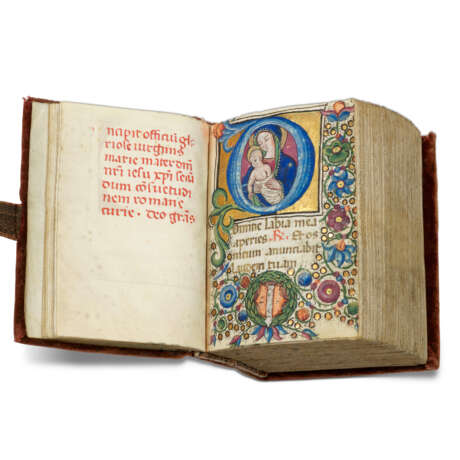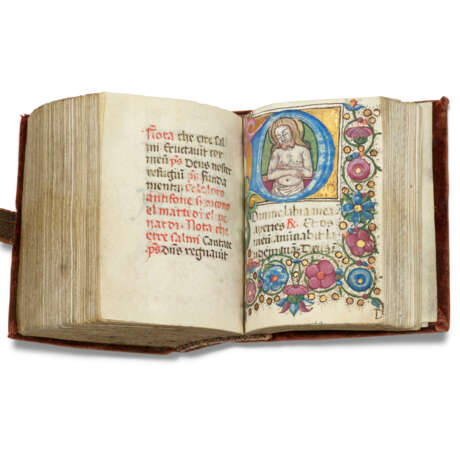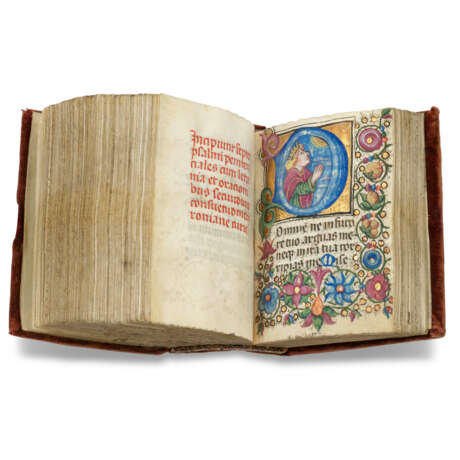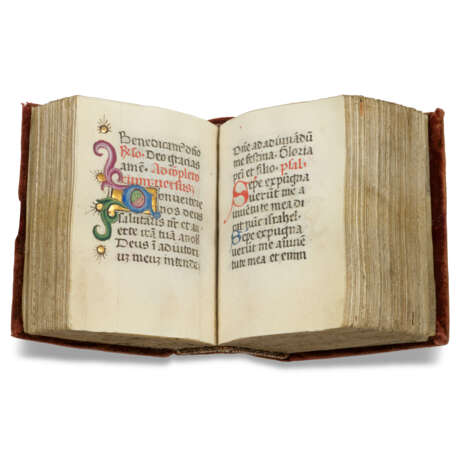ID 794614
Lot 29 | Circle of Bernardino Cignoni
Estimate value
£ 10 000 – 15 000
Book of Hours, use of Rome, in Latin and Italian, illuminated manuscript on vellum [Siena, final quarter 15th century]
A charming example of a miniature Italian Book of Hours, illuminated by an artist in the ambit of Bernardino Cignoni and owned and personalised by a 16th-century woman called Eufrasia.
81 x 61 mm, i+382+i leaves, collation: 1-910, 1010 (with gatherings 11 and 12 inserted between vi and vii), 1110, 124, 13-3110, 328, 33-3810, 394, 406, catchwords survive and traces of gathering signatures survive on gatherings 1-9 and 13-38, repeating signature D on gathering 38; 10-12 lines of text in two hands, the second copying terce and sext in the Hours of the Virgin and the Italian prayers at the end, ruled space: 45 x 35mm., rubrics in red and initials in alternating red and blue throughout, 14 illuminated initials, 4 large historiated initials within full borders (minor marginal cropping, some fading of blue pigment to historiated initials, small marginal tear to f.57). Old red velvet over wooden boards, edges gilt and gauffered, brass catch, inscribed ‘AVE’, red-velvet strap and fastening pin.
Provenance:
(1) The four patron saints of Siena, Ansano, Crescenzio, Savino and Vittore all appear in the Calendar and the Litany, and the style of illumination indicates a Sienese production.
(2) Eufrasia (da Vecchiano?): the text for terce and sext was replaced in the 16th century and a final gathering with three additional prayers in Italian was added, with the name ‘Frasia’ appearing three times – ‘Io misera peccatrice Frasia’ (f.377); ‘me peccatrice frasia’ (f.379), both in a professional hand, and ‘o pecatrice frasia’ (f.382v), perhaps in autograph. The coat of arms at the bas-de-page of f.21 was likely originally left blank, and was later painted gules, per pale argent, three ?roses of the field, with initials either side, now illegible (but possibly an ‘E’ on the left). The arms are that of the da Vecchiano (or Vecchiani) family of Pisa. A Girolamo da Vecchiano (d. c.1560) was a condottiere di ventura who took part in the uprising in Siena organised by Leone Ricasoli on behalf of Cosimo de Medici in May 1552.
(3) Bonhams, 18 March 2015, lot 67.
Content: Calendar ff.1-18v; Hours of the Virgin, use of Rome, ff.21-163: matins f.21, lauds f.42v, prime f.87v, terce f.97, sext f.104v, none f.111, vespers f.119v, compline f.135v; Office of the Dead, use of Rome ff.165-268v; Penitential Psalms and Litany ff.269-312v, Hours of the Passion ff.313-375: matins f.313, lauds f.333v, prime f.341, terce f.345v, sext f.351, none f.356, vespers f.361, compline f.369; blank f.376; prayers for communion, in Italian, ff.377-382v.
Illumination:
The bold palette of blues, greens and pinks, and the angular, strongly delineated figures are very similar to the work of the Sienese illuminator Bernardino Cignoni (d.1496). Cignoni illuminated manuscripts for Siena Cathedral and Chancery, and a number of local religious confraternities and aristocratic families, such as the Piccolomini and the Bichi (see M. Cignoni, ‘Bernardino Cignoni di Siena miniatore di libri (m. 1496)’, Honos alit artes: Studi per il settantesimo compleanno di Mario Aschieri, 2014, vol. 2, pp.269-73). The style of illumination finds direct comparables in two other manuscript Hours also attributed to Cignoni or his circle: one is the Hours of Filitiana Bichi (New York, Pierpont Morgan Library, MS M 311); and the other the Mountnorris Book of Hours, recently with Dr. Jörn Günther (especially the depiction of the Virgin and Child opening the Hours of the Virgin).
The subjects of the large historiated initials are as follows: initial ‘D’ with the Virgin and Child and at the bas-de-page the arms gules, per pale argent, three ?roses of the field f.21; initial ‘V’ with a skull f.165; initial ‘D’ with David in prayer f.269; initial ‘D’ with Christ as Man of Sorrows f.313.
The illuminated initials are on ff.21, 87v, 97, 104v, 111, 119v, 135v, 333v, 341, 345v, 351, 356, 361, 369.
Special notice
No VAT on hammer price or buyer's premium.
| Place of origin: | Italy, Europe |
|---|---|
| Auction house category: | Medieval & renaissance manuscripts |
| Place of origin: | Italy, Europe |
|---|---|
| Auction house category: | Medieval & renaissance manuscripts |
| Address of auction |
CHRISTIE'S 8 King Street, St. James's SW1Y 6QT London United Kingdom | |
|---|---|---|
| Preview |
| |
| Phone | +44 (0)20 7839 9060 | |
| Buyer Premium | see on Website | |
| Conditions of purchase | Conditions of purchase |






